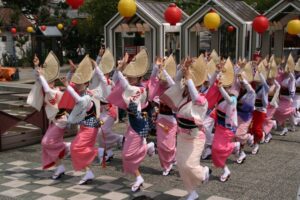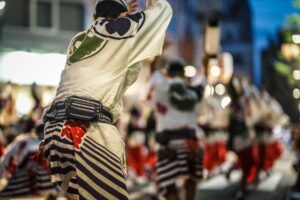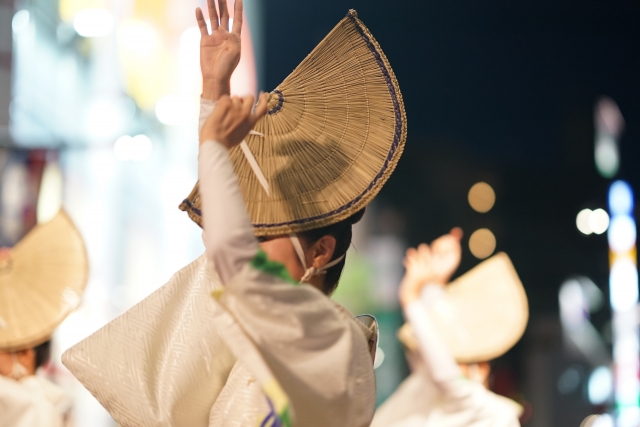Every August, the heart of Tokushima City comes alive with a unique, electric energy.
As night falls, the streets resonate with the rhythms of taiko drums, kane bells, and shamisen. Dancers in vibrant costumes weave through the city, moving with both graceful elegance and powerful dynamism.
Passersby instinctively stop in their tracks, mesmerized by the fluid, captivating motion.
A well-known chant echoes the spirit of the event: “The dancers are fools, the watchers are fools. If both are fools, you might as well dance!”
This phrase encapsulates the heart of the festival—it’s all about participation.
The boundary between performers and spectators fades, inviting everyone to join the ever-growing circle of dance.
This is no mere tourist attraction. Awa Odori is a deeply rooted cultural expression, a living tradition intertwined with the daily lives of the local people.
Folk Power Behind Its Origins and History
Though its precise origin remains debated, the most widely accepted theory traces Awa Odori back to the late 16th century.
Around 1586, feudal lord Hachisuka Iemasa, who governed the Awa Domain (present-day Tokushima Prefecture), is said to have hosted a grand celebration marking the completion of Tokushima Castle. At this feast, sake and dancing were freely offered to the townspeople. What began as spontaneous revelry on the castle grounds soon spread into the streets and evolved into the lively dance we know today.
Hachisuka Iemasa, a samurai under Toyotomi Hideyoshi and the first daimyo of the Tokushima Domain, oversaw the development of Tokushima Castle as a center of politics, commerce, and culture. Within this flourishing castle town, Awa Odori took root as a cherished tradition among the common people.
Additionally, Awa Odori is recognized as a type of Bon Odori—a traditional dance meant to honor ancestral spirits during the Obon season.
While its religious significance has gradually faded, the festival has endured as a vibrant cultural event that continues to strengthen community ties.

Awa Odori is considered one of the three great Bon dances of Japan.
The Beauty and Energy of the “Ren” Dance Groups
Awa Odori is performed by organized groups known as ren.
Each ren features unique costumes, choreography, and musical arrangements. From prestigious troupes of expert dancers to smaller, family-oriented groups formed by local residents, dancers of all ages and backgrounds come together.
The dance style is broadly divided into male and female forms.
Male dancers adopt a low, powerful stance, stepping with bold, crossing leg movements that exude vigor.
Female dancers, wearing woven hats called amigasa, move with delicate precision, each fingertip expressing refined elegance.
Tokushima City Awa Odori 2025: The dynamic group beauty of the Honma-ren, Wakajishi-ren, and Shinbashi-ren is a true highlight of the festival.
Again, the festival’s signature phrase—“The dancers are fools, the watchers are fools…”—perfectly embodies its ethos.
Whether you’re performing or observing, the dance creates a shared space that unites everyone in the moment. That’s the essence of Awa Odori.
Why the Dance Endures
How has Awa Odori captivated people for more than four centuries?
Historical records show that during the Edo period, the Tokushima Domain repeatedly issued edicts to restrain or ban the dance out of fear it might provoke uprisings or unrest.
That a folk celebration could challenge authority speaks to the profound emotional force this dance has carried through generations.
At the heart of it all lies the festival’s simple yet profound message: Don’t worry about being good or bad—just dance and let your spirit fly.
This liberating principle is the driving force behind Awa Odori.

“The dancers are fools, the watchers are fools. If both are fools, you might as well dance.” — This phrase captures the very essence of Awa Odori.
Dancers surrender to the rhythm, free from constraints of skill or age, expressing their full selves in the present moment.
In this act of pure movement—just dancing—there resides a meaning too deep for words.
Perhaps this is why, even after 400 years, people still feel drawn to it.
Living Tradition in the Modern Age
Today, Tokushima City hosts the Awa Odori Festival annually from August 12 to 15, attracting hundreds of thousands of spectators from across Japan and the world.
It stands as one of Japan’s largest and most iconic summer festivals.
Yet, despite its scale and spectacle, the spirit at its core remains unchanged.
As bodies sway to the beat of the drums, participants share not only rhythm but a sense of connection to something timeless.
Awa Odori is more than a dance—it is the embodiment of a spirit passed down through generations.




コメント